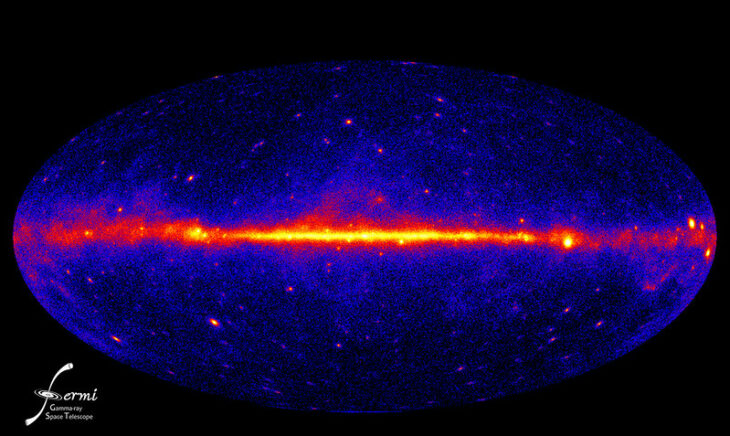Centuries before astronomers theorized the Big Bang, they realized that if the universe were infinite in size, unchanging over time, and full of stars, then there would be no dark spots in the night sky. If the universe has stars everywhere, then starlight would fill every point in the sky. And if it’s been the same over time, then all this starlight would already have reached Earth, making the sky uniformly bright.
This realization is known as Olbers’s paradox, and it suggests that since there are gaps of darkness between stars, the universe can’t be both infinite and unchanging. Instead, astronomers think the universe has changed over time, beginning with the Big Bang. These changes prevent the sky from being bathed in starlight because even if the universe is infinite and full of stars, only some stars’ light has had time to reach Earth.
Although the sky isn’t filled with starlight, it is awash in other kinds of light. The most well-known type is long-wavelength radiation leftover from the Big Bang, known as the cosmic microwave background, or CMB. Another type is short-wavelength radiation that comes from outside the galaxy, known as the extragalactic gamma-ray background or EGB. The source of EGB is more mysterious than that of CMB, with potential candidates ranging from black holes at the centers of distant galaxies to subatomic particle reactions, to possibly even dark matter.
Since astronomers discovered EGB in the 1970s, scientists have identified specific large, high-energy objects, such as active galactic nuclei and star-forming galaxies, that produce approximately half of the EGB. These objects form bright spots of resolved EGB that are near enough to observe from Earth.
This still leaves half of the EGB unaccounted for or unresolved. The unresolved EGB is diffuse, meaning its source is too far away to spot with telescopes. To find the source for the unresolved EGB, a team of scientists investigated the hypothesis that galaxies are a major, if not dominant, contributor. They reasoned that nearby galaxies are a source of resolved EGB, so distant galaxies could be a similar source of diffuse unresolved EGB.
Astronomers think galaxies create gamma rays via a specific sequence of events. First, galaxies create stars, which then explode or go supernova. Supernovae accelerate particles like protons and electrons to high velocities, moving so fast they’re referred to as cosmic rays. Cosmic rays collide with each other and release energy, causing a chain reaction that ends in smaller particles and a gamma ray. These gamma rays exist within a range of possible energies, which, for the scope of this study, is around 0.01 to 1,000 gigaelectronvolts or GeV.
The researchers developed a model to estimate the amount of gamma-ray radiation a galaxy could realistically produce and the energy of those gamma rays. To model this, they derived 2 equations to calculate how frequently a galaxy produces cosmic rays based on how frequently it creates stars. They needed physical data from galaxies, such as their masses, radii, and rate of star formation, to complete their model.
They used data from 22,087 galaxies in the GOODS-S catalog, which was collected using the Hubble Space Telescope. They used their model to estimate how much gamma-ray radiation those galaxies should be contributing to their small region of the sky. Then, they compared their model estimates to the actual observations of gamma-ray radiation from each galaxy using the Fermi Gamma-Ray Telescope.
They found that within the 1 to 10 GeV energy range for gamma-ray radiation, these galaxies could account for 50-60% of the unresolved EGB across all of space, but not all of it. On top of that, at both the lower end of the energy range, less than 1 GeV, and the higher end of the energy range, greater than 10 GeV, the contribution of galaxies drops off sharply. They claimed that their results showed that previous researchers who explored the SFG hypothesis likely overestimated their contribution to the unresolved EGB by a factor of 2.
The team concluded that something beyond star-forming galaxies must be responsible for the unresolved EGB in outer space. They recommended that future researchers examine active galactic nuclei and millisecond pulsars as potentially fruitful candidates. Finally, they pointed out that since galaxies aren’t the dominant source of the unresolved EGB, this leaves open the possibility that strange and so-far undetected interactions, like dark matter annihilation, could be part of the puzzle.


